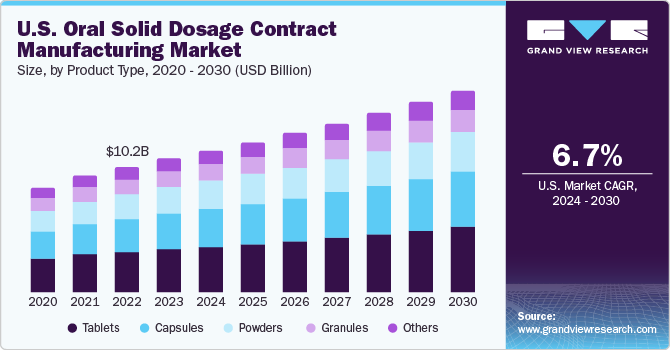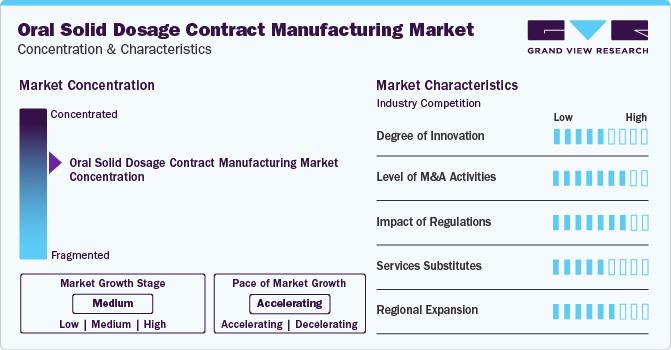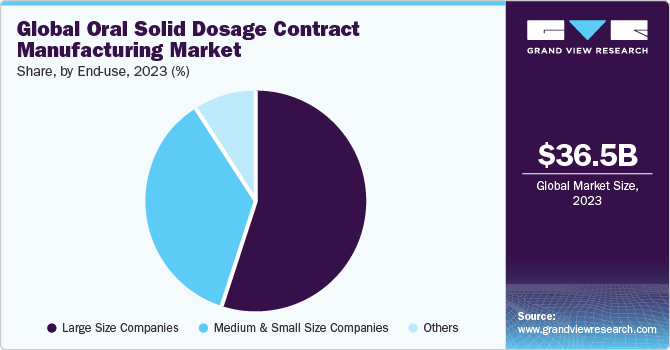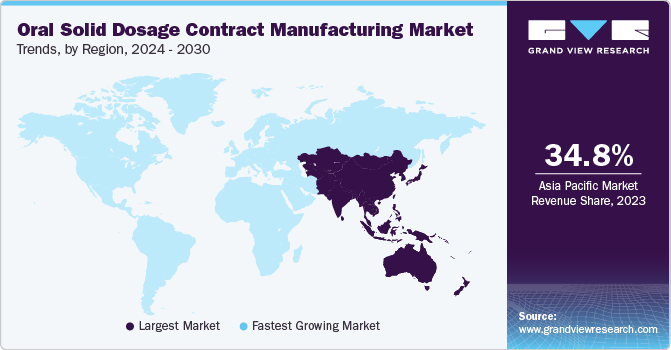- Home
- »
- Medical Devices
- »
-
Oral Solid Dosage Contract Manufacturing Market Report 2030GVR Report cover
![Oral Solid Dosage Contract Manufacturing Market Size, Share & Trends Report]()
Oral Solid Dosage Contract Manufacturing Market Size, Share & Trends Analysis Report By Product Type (Tablets, Capsules, Powders, Granules), By Mechanism, By End-use, By Region, And Segment Forecasts, 2024 - 2030
- Report ID: GVR-4-68039-948-4
- Number of Report Pages: 193
- Format: PDF, Horizon Databook
- Historical Range: 2018 - 2023
- Forecast Period: 2024 - 2030
- Industry: Healthcare
Market Size & Trends
The global oral solid dosage contract manufacturing market size was estimated at USD 36.50 billion in 2023 and is projected to grow at a compound annual growth rate (CAGR) of 5.97% from 2024 to 2030. Growth in the market can be attributed to the increasing advancements in drug delivery technology, including targeted drug delivery & sustained release dosage forms, investments by contract development manufacturing organizations to expand the oral solid dosage development, and demand for novel therapies.

In addition, oral pharmaceutical products are likely to be replaced with new technologies anytime shortly. For instance, integrating 3D printing in OSD manufacturing can enable precise control over drug release and help customize dosage forms based on patient needs. This technology allows for the production of complex shapes and formulations, offering flexibility in drug design & manufacturing. Hence, the solid dose pharmaceutical manufacturing expansion is driven by solid dose formats & increased efficiency.
Furthermore, advancements in controlled-release technologies can improve drug delivery, providing sustained- & extended-release options. This enhances therapeutic efficacy and patient compliance. Adopting digital technologies and data analytics in OSD manufacturing enhances process monitoring, quality control, and efficiency. Contract manufacturers leveraging these technologies provide transparent and data-driven solutions. Such advancements are likely to create growth opportunities in the market.
Market Concentration & Characteristics
The market growth stage is stable, and market growth is expected to accelerate over the estimated period. The oral solid dosage contract manufacturing industry is characterized by regulatory considerations, evolving technologies, and globalization & outsourcing of services.

The oral solid dosage contract manufacturing market is anticipated to witness lucrative growth due to the increased outsourcing by pharmaceutical companies to reduce costs, improve efficiency, and focus on core competencies. In addition, oral solid dosage CMOs are well-versed in navigating the complex regulatory landscape, including compliance with the U.S. FDA, European Medicines Agency (EMA), & several other regulatory bodies, ensuring that products meet stringent quality and safety standards.
Furthermore, many CROs are becoming one-stop shops (full-service providers), offering an exhaustive list of core and ancillary R&D services. As pharmaceutical and biopharmaceutical companies strive to improve competitiveness, collaboration with a CMO offering end-to-end services is a strategic move. This has led to increasing demand for one-stop-shop services for CMOs and CDMOs.
In addition, the market is highly competitive, characterized by numerous established and emerging players offering a wide array of services. Differentiation based on expertise, technology, regulatory compliance, and service quality is crucial for market positioning. Companies leveraging advanced oral solid dosage contract manufacturing technologies and innovative methodologies gain a competitive edge. Besides, increasing research activities, pharmaceutical companies, and government support for drug development contribute to market growth.
Ongoing advancements in formulation technologies create opportunities for contract manufacturers to differentiate themselves by offering innovative OSD forms. Besides, automation & robotics are gaining traction in the OSD contract manufacturing industry. This technology improves the accuracy of the manufacturing process, reduces human error, and increases overall efficiency.
Strong technical expertise in pharmaceutical formulation & regulatory compliance allows companies to offer high-quality services and adapt to evolving industry requirements. Larger CMOs benefit from economies of scale, enabling them to negotiate better deals with suppliers, invest in advanced technologies, and offer competitive pricing. This enhances their market competitiveness and profitability.
Market players like Catalent, Inc., Lonza, Recipharm AB., and Corden Pharma. are involved in merger and acquisition activities. Through M&A activity, these entities can expand their geographic reach and strengthen their market position. Understanding the competitive landscape helps businesses position themselves effectively and enhance the development of oral solid formulations and other services.
A continuation of manufacturing capacity expansion by CMOS & CDMOS for OSD is expected to improve the production of oral solid formulations, boosting the market. This can lead to the adoption of more efficient and advanced manufacturing techniques in the production of oral solid dosage forms. This factor further supports CMOs and CDMOs in offering larger volumes of oral solid dosage production to meet the increasing demand from pharmaceutical companies.
The market expansion in the region can be attributed to the presence of technologically advanced Contract Manufacturing Organizations (CMOs) & Contract Development and Manufacturing Organizations (CDMOs) and a surge in the allocation of grants. Furthermore, increasing drug development activities, strategic measures like innovation & acquisitions, the presence of pharmaceutical companies, and a rise in the demand for oral solid dosage products in the region are propelling market growth.
Product Type Insights
Based on product type, the tablets segment held the largest market share of 32.7% in 2023. Solid dosage forms, specifically tablets, are recognized as cost-effective pharmaceuticals. The expected rise in demand for these products is poised to drive growth within this segment. Furthermore, technological advancements, such as continuous manufacturing and 3D printing, that improve the efficiency of manufacturing processes are expected to enhance segment growth. For instance, The Technology House (TTH) acquired an SLA 750 3D printer from 3D Systems. This acquisition was aimed at strengthening and streamlining the manufacturing processes. By integrating the capabilities of the SLA 750 printer, including its rapid production speed, expansive build area, and diverse material selection, TTH is expected to expand the array of services it offers to its customers.
Besides, the capsules segment is expected to grow at a lucrative CAGR of 6.44% over the forecast period. The growing advantages of capsules, such as ease of swallowing, faster disintegration, and absorption, are expected to drive the market. These capsules disintegrate more quickly, rapidly releasing and absorbing medication. Moreover, technological advancements and the growing adoption of such technologies for expanding capsule-filling capabilities are expected to drive market growth. For instance, in December 2023, Pace Life Sciences and Division of Pace integrated liquid capsule filling technology into its extensive array of services for oral solid dose development. Incorporating this innovative liquid capsule filling technology allows the company to extend assistance from early-phase to late-phase clinical trials, enhances the capabilities for handling viscous formulations, and protects oxygen-sensitive products through nitrogen overlay.
Mechanism Insights
Based on mechanism, the controlled release segment accounted for 52.2% of the market share in 2023. This drug delivery mechanism maintains a consistent drug concentration in the tissues and bloodstream over an extended duration. Recent advancements in oral CR delivery systems, including intestinal patches, polymer nanosystems, dome tablets, dual drug tablets, and bioinspired delivery methods, such as exosomes, have revolutionized the field.
The immediate release (IR) segment is expected to grow at a CAGR of 5.85%. The IR dosage forms, often referred to as conventional release dosage forms, facilitate the rapid absorption of drugs on oral administration. In certain instances, they are formulated as dispersible dosage forms designed to dissolve or disintegrate before ingestion. Within the spectrum of various dosage forms, those exhibiting IR attributes have the highest usage in the pharmaceutical market, attributed to their ability to enable swift therapeutic outcomes.
End-use Insights
Based on end-use, the large size companies segment accounted for 54.8% of the market share in 2023. Large pharmaceutical companies outsource oral solid dose formulations & manufacturing, attributing quality & reliability as the top two positions; however, priorities diverge from there. Besides, established pharma ranks productivity second, followed by affordability, innovation, and regulation. On the other hand, Contract Manufacturing Organizations (CMOs) specializing in oral solid dosage can provide several benefits to large pharmaceutical companies, leading to their increased adoption.

The medium & small size companies segment is estimated to show growth at a lucrative rate in the market over the forecast period. Growth in the segment can be attributed to the increasing number of small- & medium-sized companies outsourcing to CMOs. Outsourcing drug manufacturing is a preferred option for drug developers who may not incorporate the infrastructure to develop standards and small molecule APIs. Such factors are expected to drive market growth.
Regional Insights
Asia Pacific dominated the global oral solid dosage contract manufacturing market in 2023, holding a revenue share of 34.8%. This growth can be attributed to various factors, such as improved social insurance schemes and constantly improving economic conditions in the region, which allow patients to pay out-of-pocket pharmaceutical costs. In recent years, countries such as Singapore, China, and India have been observed to be major players in the pharmaceutical industry owing to their expanding capabilities of the oral solid dosage contract manufacturing process.In addition, in the past decade, manufacturing of pharmaceutical products has been outsourced to Asian countries, including India and China. Furthermore, the availability of several potential study subjects has driven many pharmaceutical companies, such as Eli-Lilly and GlaxoSmithKline, to conduct clinical studies in Asian countries such as India.

North America is estimated to show growth at a lucrative rate in the market over the forecast period owing to growing investments in R&D of new drugs by pharmaceutical companies, which boosts the demand for oral solid dosage contract manufacturing. The growth of pharmaceutical industry in the U.S. and Canada is a crucial factor contributing to market growth. In addition, the presence of key market players and ongoing clinical trials are anticipated to drive market growth.
Key Companies & Market Share Insights
Participants are acquiring various strategic initiatives to strengthen their market position, offering diverse services globally. The prominent strategies adopted by companies are acquisitions, collaborations, expansion, services launches, partnerships, and others to increase market presence & revenue and gain a competitive edge. These initiatives may be implemented to expand regionally or widen the global network to reach more customers.
Key Oral Solid Dosage Contract Manufacturing Companies:
- Catalent, Inc.
- Lonza
- Aenova Group
- Boehringer Ingelheim International GmbH
- Jubilant Pharmova Limited
- Patheon Pharma Services
- Recipharm AB.
- Corden Pharma International
- Siegfried Holding AG
- Piramal Pharma Solutions
- AbbVie Contract Manufacturing
- Next Pharma AB
Recent Developments
-
In July 2023, Aenova Group and Galvita entered a strategic partnership to improve oral dosage forms’ development, formulation, and production. This collaboration aims to bring Galvita’s child- and senior-specific knowledge of formulations featuring better taste masking, faster oral disintegration, and higher drug loading to Aenova’s currently available portfolio of oral dosage forms in the market.
-
In April 2023, Aenova invested approximately USD 21.96 million (20 million euros) to expand its high-volume solids site in Tittmoning, resulting in increased capacity. The investment is attributed to the increasing demand for film-coated tablets, conventional oral solids tablets, and hard capsules.
-
In March 2023, the clinical and commercial drug product manufacturing line in Visp was completed by Lonza. The expansion will support the company in strengthening its drug product services offering. The manufacturing unit is part of Lonza’s Ibex Biopark, which includes mammalian manufacturing, bioconjugation, and microbial development.
Oral Solid Dosage Contract Manufacturing Market Report Scope
Report Attribute
Details
Market size value in 2024
USD 38.6 billion
Revenue forecast in 2030
USD 54.7 billion
Growth rate
CAGR of 5.97% from 2024 to 2030
Historical Year
2018 - 2023
Forecast period
2024 - 2030
Quantitative units
Revenue in USD million and CAGR from 2024 to 2030
Report coverage
Revenue forecast, company ranking, competitive landscape, growth factors, trends
Segments covered
Product type, mechanism, service, drug potency, prescription type, therapeutic area, end-use, region
Regional scope
North America; Europe; Asia Pacific; Latin America; MEA
Country scope
U.S.; Canada; UK; Germany; France; Italy; Spain; Denmark; Sweden; Norway; China; India; Japan; Australia; South Korea; Thailand; Brazil; Mexico; Argentina; South Africa; Saudi Arabia; UAE; Kuwait
Key companies profiled
Catalent, Inc.; Lonza; Aenova Group; Boehringer Ingelheim International GmbH; Jubilant Pharmova Limited; Patheon Pharma Services; Recipharm AB.; Corden Pharma International; Siegfried Holding AG; Piramal Pharma Solutions; AbbVie Contract Manufacturing Pharma; Next Pharma AB
Customization scope
Free report customization (equivalent up to 8 analysts working days) with purchase. Addition or alteration to country, regional & segment scope.
Pricing and purchase options
Avail customized purchase options to meet your exact research needs. Explore purchase options
Global Oral Solid Dosage Contract Manufacturing Report Segmentation
This report forecasts revenue growth at global, regional, and country levels and provides an analysis of the latest industry trends in each of the sub-segments from 2018 to 2030. For this study, Grand View Research has segmented the global oral solid dosage contract manufacturing market report based on product type, mechanism, service, drug potency, prescription type, therapeutic area, end-use, and region.
-
Product Type Outlook (Revenue, USD Million, 2018 - 2030)
-
Tablets
-
Compressed Tablets
-
Orally Disintegrating Tablets (ODT)
-
Chewable Tablets
-
Bi-layer or Tri-layer Tablets
-
Sublingual or Buccal Tablets
-
Others
-
-
Capsules
-
Hard Gelatin Capsules
-
Soft Gelatin Capsules
-
-
Powders
-
Granules
-
Others
-
-
Mechanism Outlook (Revenue, USD Million, 2018 - 2030)
-
Immediate Release
-
Delayed Release
-
Controlled Release
-
-
Service Outlook (Revenue, USD Million, 2018 - 2030)
-
Drug Product Development
-
Fill Finish Product Manufacturing
-
API Manufacturing
-
Others
-
-
Drug Potency Outlook (Revenue, USD Million, 2018 - 2030)
-
High Potent Drugs
-
Moderate Potent Drugs
-
Low Potent Drugs
-
-
Prescription Type Outlook (Revenue, USD Million, 2018 - 2030)
-
Prescription Drugs
-
Over-The-Counter Drugs
-
-
Therapeutic Area Outlook (Revenue, USD Million, 2018 - 2030)
-
Oncology
-
Cardiovascular Diseases
-
Metabolic Disorders
-
Neurological Disorders
-
infectious Diseases
-
Gastrointestinal Diseases
-
Other Therapeutic Areas
-
-
End Use Outlook (Revenue, USD Million, 2018 - 2030)
-
Large Size Companies
-
Medium & Small Size Companies
-
Others
-
-
Regional Outlook (Revenue, USD Million, 2018 - 2030)
-
North America
-
U.S.
-
Canada
-
Mexico
-
-
Europe
-
UK
-
Germany
-
France
-
Italy
-
Spain
-
Denmark
-
Sweden
-
Norway
-
-
Asia Pacific
-
China
-
India
-
Japan
-
Australia
-
South Korea
-
Thailand
-
-
Latin America
-
Brazil
-
Argentina
-
-
Middle East and Africa (MEA)
-
South Africa
-
Saudi Arabia
-
UAE
-
Kuwait
-
-
Frequently Asked Questions About This Report
b. The global oral solid dosage contract manufacturing market size was estimated at USD 36.5 billion in 2023 and is expected to reach USD 38.6 billion in 2024.
b. The global oral solid dosage contract manufacturing market witnessed a moderate growth rate of 5.97% from 2024 to 2030 to reach USD 54.7 billion by 2030.
b. Tablets held the largest market share of 32.7%share in 2023. Solid dosage forms, specifically tablets, are recognized as cost-effective pharmaceuticals. The expected rise in demand for these products is poised to drive growth within this segment.
b. Some key players operating in the oral solid dosage contract manufacturing market include Boehringer Ingelheim International GmbH, Lonza, Catalent, Inc, Aenova Group, Jubilant Pharmova Limited, Patheon Pharma Services, Recipharm AB. and a few others.
b. Increasing advancements of drug delivery technology, including targeted drug delivery & sustained release dosage forms, and investments by contract development manufacturing organizations are a few factors supporting the market growth.
Share this report with your colleague or friend.
![gvr icn]()
NEED A CUSTOM REPORT?
We can customize every report - free of charge - including purchasing stand-alone sections or country-level reports, as well as offer affordable discounts for start-ups & universities. Contact us now
![Certified Icon]()
We are GDPR and CCPA compliant! Your transaction & personal information is safe and secure. For more details, please read our privacy policy.
We are committed towards customer satisfaction, and quality service.
"The quality of research they have done for us has been excellent."





